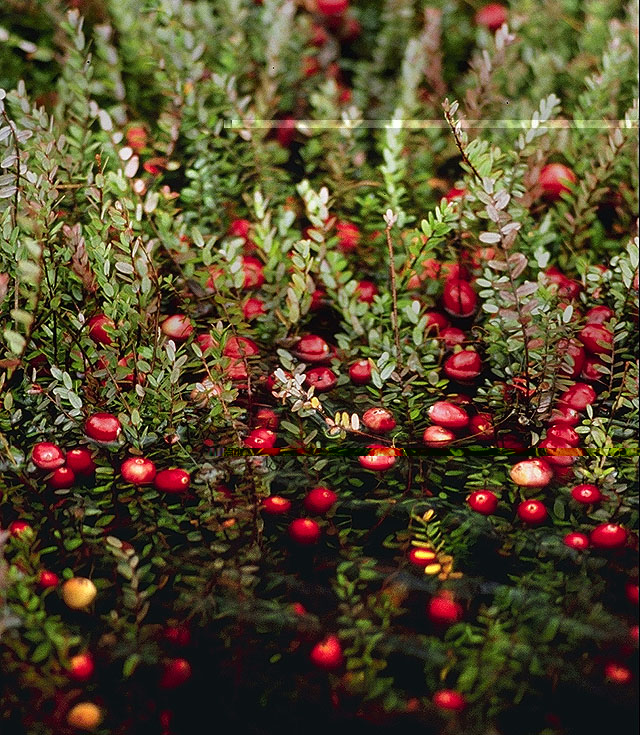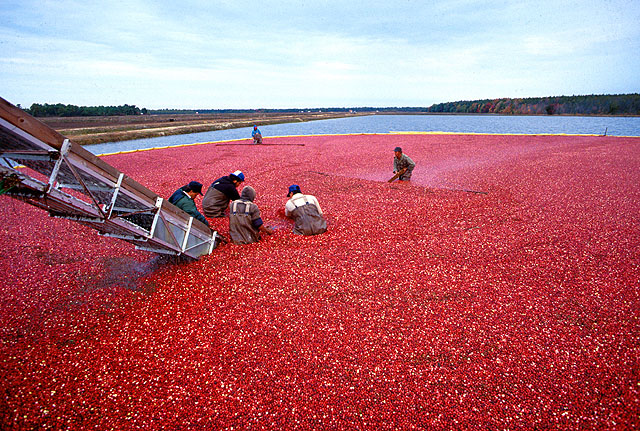Elaine M. D'Sa, Ph.D.
National Center for Home Food Preservation
October 2003

Fall is here - along with the crunch of leaves underfoot and the making of plans for the not-too-distant holiday season. And for the avid cook – dusting off recipes for time-honored culinary traditions that include America’s much-loved bird with all the accompaniments. No Fall or Winter holiday table would be complete without at least one cranberry item. It assumes even more significance being one of three fruits native to North America (the others are the blueberry and the Concord grape).

The cranberry (called ‘crane’berry by the Pilgrims) is a wetland fruit (Vaccinium macrocarpon) that is cultivated on low-growing vines in natural or artificial ‘bogs’. Wisconsin, Massachusetts, New Jersey, Oregon and Washington are the main cranberry growing states. Harvest starts in September, and continues through November. The fresh fruit is available in stores from October through December/early January, usually in 12-ounce bags (equivalent to 3 cups of whole berries). Several cranberry products have made their entrance into supermarket aisles, including juice drinks and blends, frozen fruit, canned sauces, crushed fruit, dried berries and snack mixes containing dried cranberries.
Selection and Storage: The berries should be brightly colored: fully red or yellowish-red with a smooth, glossy and firm skin. Shriveled, soft, wrinkled berries or those with surface blemishes should be discarded. Berries can be stored in the original packaging in the refrigerator crisper for up to 4 weeks. Cranberries can also be stored frozen for up to one year. To use after freezing, rinse in cold water and drain well.
Nutritional Value: The acid berries are high in vitamin C – a cup of raw cranberries provides about a fifth of the daily Vitamin C requirements for adults. Studies have shown that cranberries have significant amounts of antioxidants that may protect against heart disease and certain types of cancer, and the importance of cranberries in promoting urinary tract health has been extensively studied.

Uses: Raw cranberries are very tart and bland-tasting, but incorporating them as fresh or dried fruit in recipes adds color and a pleasing texture to the dish, as the berries are high in natural pectin that helps gel development. Use fresh cranberries for home-preserved novel canned items like Spicy Cranberry Salsa, Cranberry Orange Chutney and Cranberry Conserve. These make attractive gift items to be included in holiday gift baskets, or to grace that special-occasion table setting. Use the chutney as a piquant side dish or to perk-up a sauce. The Spicy Cranberry Salsa can be used directly as a dip, stirred into cream cheese just before use to make a dipping sauce-with-a-difference, or used as a side item as an accompaniment to meats. The Cranberry Conserve is delicious on warm toast - use it to make those family breakfasts special! Make your own canned Cranberry Sauce for holiday use, or to stir into yogurt or homemade ice cream. Whole cranberries in syrup can be canned when the berries are in season, and home-dried cranberries provide a healthy, economical alternative to high-calorie store-bought snacks.
So, start the holiday season early and enjoy making these attractive homemade ‘crane'berry treats!
References and additional information on cranberry history, cultivation, harvesting and trivia can be found at the following websites:
- Rutgers Cooperative Extension:
http://aesop.rutgers.edu/%7Ebluecran/homepage.htm - The Cranberry Marketing Committee:
www.uscranberries.com/eng/consumer.cfm - The Cape Cod Cranberry Growers' Association:
www.cranberries.org - University of Maine Cooperative Extension:
http://www.umaine.edu/umext/cranberries/ - University of Massachusetts Cranberry Station websites:
http://www.umass.edu/cranberry/
http://www.umass.edu/cranberry/downloads/nathist.pdf
Elaine M. D’Sa is Research Coordinator with the National Center for Home Food Preservation, Department of Foods and Nutrition, College of Family and Consumer Sciences, The University of Georgia, Athens.
Images are courtesy of the United States Department of Agriculture, Agricultural Research Service Image Gallery, Images K4414-14 (Cranberry bog) and K4418-6 (Cranberry harvest); and the National Center for Home Food Preservation, The University of Georgia, Athens, GA.
This material is based upon work supported by the Cooperative State Research, Education, and Extension Service, U.S. Department of Agriculture, under Agreement No. 00-51110-9762.
Document Use:
Permission is granted to reproduce these materials in whole or in part for educational purposes only (not for profit beyond the cost of reproduction) provided the authors and the University of Georgia receive acknowledgment and this notice is included:
Reprinted with permission of the University of Georgia. E. D’Sa. 2003. Using and Preserving Cranberries. Athens, GA: The University of Georgia, Cooperative Extension Service.
References to commercials products, services, and information is made with the understanding that no discrimination is intended and no endorsement by the University of Georgia, U.S. Department of Agriculture and supporting organizations is implied. This information is provided for the educational information and convenience of the reader.